ABSTRACT
An L-shaped dual-band multiple-input multiple-output (MIMO) rectangular dielectric resonator antenna (RDRA) for long term evolution (LTE) applications is proposed. The presented antenna can transmit and receive information independently using fundamental TE 111 and higher order TE 121 modes of the DRA. TE 111 degenerate mode covers LTE band 2 (1.85–1.99 GHz), 3 (1.71–1.88 GHz), and 9 (1.7499–1.7849 GHz) at fr = 1.8 GHz whereas TE 121 covers LTE band 7 (2.5–2.69 GHz) at fr = 2.6 GHz, respectively.
An efficient design method has been used to reduce mutual coupling between ports by changing the effective permittivity values of DRA by introducing a cylindrical air-gap at an optimal position in the dielectric resonator. This air-gap along with matching strips at the corners of the dielectric resonator keeps the isolation at a value more than 17 dB at both the bands.
The diversity performance has also been evaluated by calculating the envelope correlation coefficient, diversity gain, and mean effective gain of the proposed design. MIMO performance has been evaluated by measuring the throughput of the proposed MIMO antenna. Experimental results successfully validate the presented design methodology in this work.
GEOMETRY OF THE PRESENTED ANTENNA
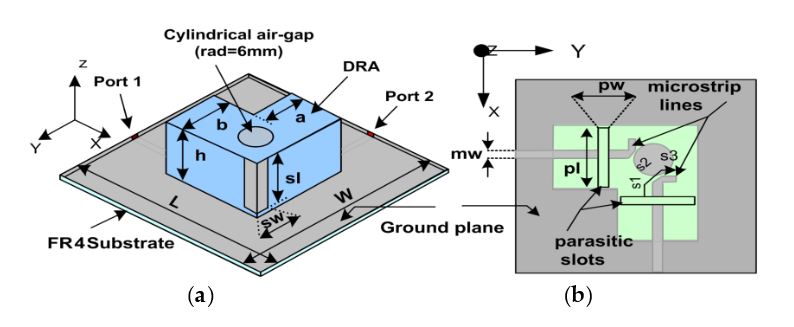
Figure 1. Presented antenna Geometry (a) 3-D view; (b) Top view
The geometry of the proposed design is shown in Figure 1. It consists of an L-shaped rectangular dielectric resonator (DR) excited by two symmetrical slots of equal dimensions coupled through microstrip feed lines. DR is made up of ceramic material (εr = 10) and has a loss tanδ = 0.002, and is placed on a ground plane of size 100 x 100 mm2.
ANTENNA DESIGN AND ANALYSIS
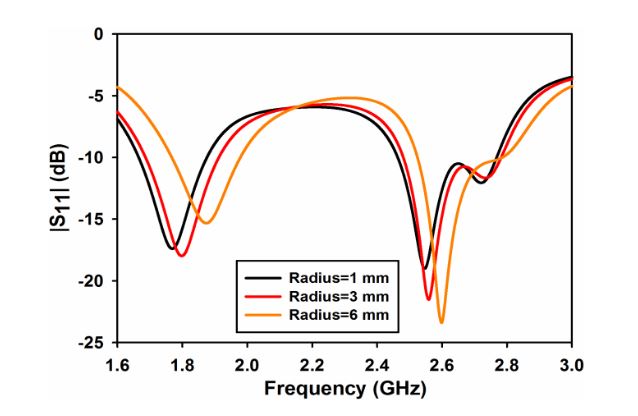
Figure 3. |S11 | for different values of cylinder radius
A parametric study on cylindrical air-gap radius rad and length of metallic strips sl is performed to evaluate the performance of the design. Figure 3 shows the effect of the cylindrical air-gap radius rad on reflection coefficient of port 1 (S11). As both ports 1 and 2 are symmetrical, only the results of port 1 are shown in the parametric study.
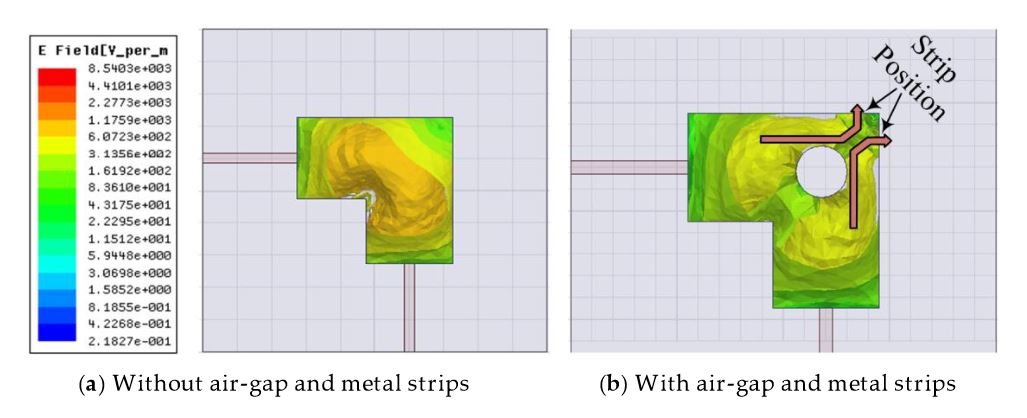
Figure 7. E-field Magnitude plot
It is well known that tangential components of electric field vanish when it strikes on a metallic surface, only the transverse component can exist. This results in further deviation of the E-fil component can exist. This results in further deviation of the E-filed originating from each port from each other resulting in a further reduction in mutual coupling. Air-gaps and metallic strips are being used to increase bandwidth and impedance matching, respectively. However, in this design this combination has been used as a coupling reduction technique. The magnitude E-field plot is shown in Figure 7.
ANTENNA PERFORMANCE MEASUREMENTS
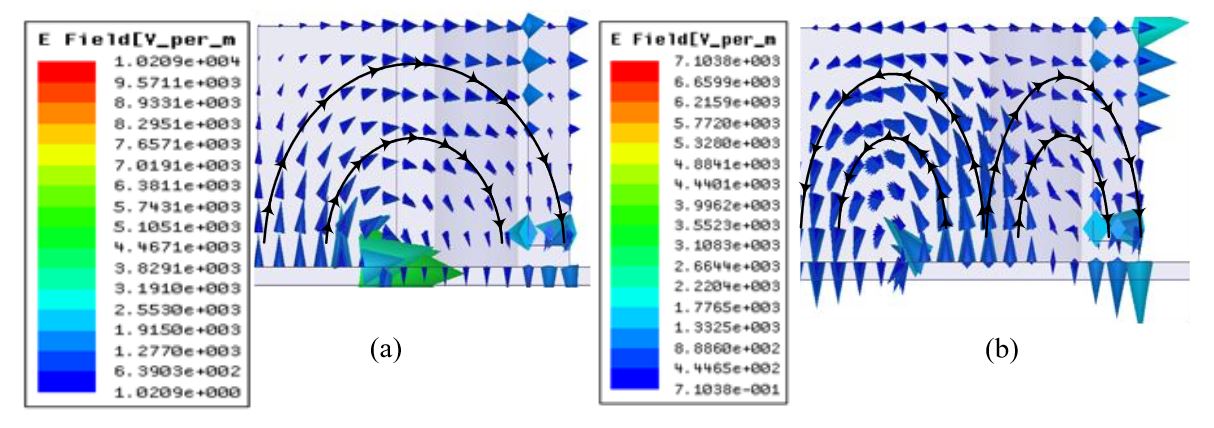
Figure 8. E-field Distribution
For the antenna to be resonating at 1.8 and 2.6 GHz, two orthogonal modes have to be excited simultaneously. Port 1 excites dominant TExδ11 and higher order TExδ21 modes whereas port 2 excites TEy1δ1 and TEy2δ1 modes, respectively. Because of the symmetry of both ports, the E-field distribution for both modes is shown in Figure 8 for port 1 only.
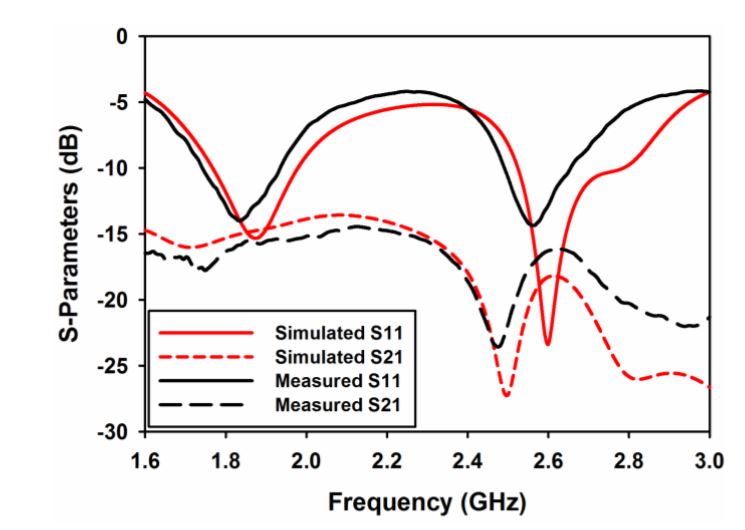
Figure 10. Measured and simulated S-parameters
Measured fractional bandwidth at 1.8 GHz is 18% (1.71–2.05 GHz) and at 2.6 GHz is 8% (2.5–2.7 GHz) through ports 1 and 2, respectively. Figure 10 indicates a good agreement between measured and simulated results. The antenna is well matched at both resonances, covering four LTE bands as mentioned earlier.
CONCLUSIONS
A dual-band dual-port MIMO RDRA fed by two symmetric coupling apertures is proposed and investigated. Two orthogonal radiating modes are excited in the DRA simultaneously at two overlapping frequency ranges around 1.8 and 2.6 GHz. The measured isolation is better than 17 dB over the operating frequency ranges. Given the same frequencies and same dielectric material, the proposed antenna is the first with a rectangular shape to be operated at given frequencies with such a high isolation values at both the bands for MIMO applications.
ECC calculated from S-parameters and 3-D radiation pattern is well below 0.5 which is the required acceptable level. Measured DG is almost 10 dB and MEG ratios are maintained close to zero at both bands. The throughput measurement at both the frequency bands indicates superior performance to an SISO system in terms of more bits transferred per second. The presented results prove that the proposed antenna can provide considerable performance for LTE MIMO applications.
Source: University Technology Malaysia
Authors: Jamal Nasir | Mohd. Haizal Jamaluddin | Aftab Ahmad Khan | Muhammad Ramlee Kamarudin | Chee Yen Leow | Owais Owais